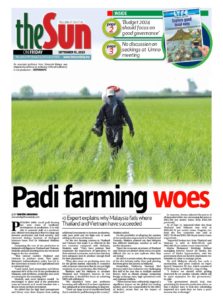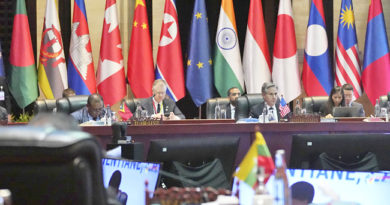HEADLINE | Padi farming woes
.
.
.
PETALING JAYA: Local padi farming has seen years of lacklustre development in production. It is only able to maintain yield at a moderate rate, which is worrying since there is a large gap between production and food security, said Universiti Malaya Institute of Biological Sciences Assoc Prof Dr Muhamad Shakirin Mispan.
Comparing the cost of rice production in Malaysia with figures in Thailand and Vietnam, Shakirin said padi planting areas are very much larger in the two countries.
“This (alone) enables Thailand and Vietnam to produce more. That apart, Malaysia’s industrialisation policy has led to the conversion of much of its agricultural land to industrial land.
“Land rental, land preparation and labour represent 80% of the cost of rice production in Malaysia, with fertilisers, pesticides and seeds accounting for the remaining 20%.”
Shakirin said more farmers would be encouraged to plant padi if the production costs are lowered as it would translate into a decent return on their investment.
He added that the high land management and labour costs deter farmers from making additional investments to increase production, with poor yield and the high cost of seeds adding to the woes of farmers.
On the rice farming systems in Thailand and Vietnam that make it so effective in the two countries compared with Malaysia, Shakirin said: “They have policies that emphasise the importance of agriculture to their national economies, and ensure that they have adequate land to produce enough food for their population.
“They also stress on producing more rice for the global market, especially to countries with economic structures that do not put high emphasis on rice production, like Malaysia.”
Shakirin said for Malaysia to emulate Thailand and Vietnam’s success in rice production, it should first focus on achieving 100% self-sufficiency.
“We shouldn’t have any problems becoming self-sufficient if we have regulations that safeguard us from depending on imports.
“There are large tracts of uncultivated land that is suitable for padi farming in the country,” Shakirin added.
On the possibility of adopting the systems of rice production as practised in Thailand and Vietnam, Shakirin pointed out that Malaysia has different landscape, weather as well as market dynamics.
“Since the economic structures of Thailand and Vietnam are distinct (from ours), it is quite difficult (for us) to just replicate what they are doing.”
He said to a certain extent, the management of the rice industry rather than padi planting has been given the priority in Malaysia.
Meanwhile, Padiberas Nasional Bhd (Bernas) said it has endured a very challenging first half of the year due to multiple external factors, such as climate change, weakening foreign exchange rates, high operational costs and regional conflicts.
“These factors have collectively triggered a significant impact on the global rice trading market, and it was compounded by the effect of India’s recent ban on the export of white rice.”
In response, Bernas adjusted the prices of all imported white rice, increasing the price to RM3,200 per metric tonne from RM2,350 previously.
As of Sept 11, imported white rice from Thailand and Vietnam was sold at RM2,901.91 per metric tonne. Fragrant rice from the two countries was sold at RM3,725.68 and RM3,369.96 per metric tonne respectively.
“Imported broken rice from Thailand and Vietnam is sold at RM2,293.44 and RM2,480.66 per metric tonne respectively.”
Mydin Mohamed Holdings Berhad managing director Ameer Ali Mydin, the owner of Mydin hypermarkets, said the government does not need to implement rice subsidies in order to manage prices.
He said Malaysia already has such a mechanism, with price controls on Super Special Tempatan 5% rice, which consists of 5% broken rice, at RM26 for a bag of 10kg.
“I believe we should avoid getting distracted by yet another subsidy, which will be quite expensive for the government,”
he said.
“The government should look into prioritising the domestic production of rice, so that it doesn’t have to look into subsidising imported rice each time we have a price increase due to shortage.”
.Raveen Aingaran
 Memento Maxima Digital Marketing
Memento Maxima Digital Marketing
@[email protected]
SPACE RESERVE FOR ADVERTISTMENT


 Memento Maxima Digital Marketing
Memento Maxima Digital Marketing






